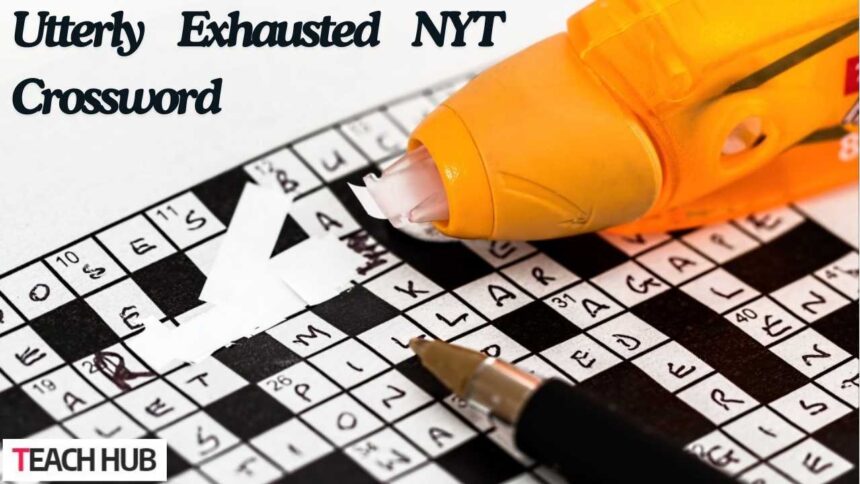As a passionate crossword enthusiast, I’ve faced my fair share of challenging clues. But few have left me as stumped as “utterly exhausted nyt crossword” in the New York Times crossword. It’s a phrase that seems simple at first glance, yet it opens up a world of possibilities when you really start to think about it. Luckily, I’ve learned some tricks over the years to tackle tricky clues like this one.
From considering multiple meanings to looking at the puzzle’s context, there are several strategies that can help unravel even the most perplexing wordplay. If you’ve ever found yourself scratching your head over a crossword clue, you’re not alone. In this article, I’ll share my insights on decoding “utterly exhausted” and other challenging clues. Whether you’re a seasoned solver or just starting out, you’ll find valuable tips to enhance your crossword skills. Keep reading to unlock the secrets of crossword mastery!
Understanding the Clue: “Utterly Exhausted”
When confronted with the clue “utterly exhausted nyt crossword” solvers are immediately thrust into a world of linguistic exploration. This phrase, seemingly simple on the surface, opens up a treasure trove of potential answers and interpretations.
The Literal Interpretation
At its most basic level, “utterly exhausted” describes a state of extreme tiredness or fatigue. This could lead solvers to consider words like depleted, drained, spent, weary, or fatigued. However, the art of crossword construction often involves layers of meaning and clever wordplay, pushing solvers to think beyond the obvious.
The Figurative Dimension
Crossword creators frequently employ figurative language to add depth to their clues. In this context, “utterly exhausted” might extend beyond physical tiredness to encompass mental exhaustion, emotional depletion, resource depletion, or completion and finality. This broader interpretation opens up new avenues for potential answers, challenging solvers to consider idioms, metaphors, and less literal interpretations of exhaustion.
The Importance of Context in Crossword Solving
While the clue “utterly exhausted” provides a starting point, experienced solvers know that context is key. Several factors can influence the intended answer:
Puzzle Theme: Many NYT crosswords, especially those published later in the week, have overarching themes. Understanding this theme can provide crucial hints for solving individual clues.
Answer Length: The number of squares available for the answer narrows down the possibilities and can guide solvers towards words of a specific length.
Crossing Words: Letters from intersecting words can provide valuable information, either confirming or eliminating potential answers.
Day of the Week: NYT crosswords typically increase in difficulty from Monday to Saturday, with Sunday puzzles being larger but of midweek difficulty. The day can give solvers an idea of how straightforward or tricky the clue might be.
Wordplay Indicators: Certain words or phrases in the clue itself might hint at anagrams, homophones, or other wordplay techniques.
The Specific Case: “BONE” as the Answer
In the case mentioned in the provided context, the answer to “With 5-Across, utterly exhausted” was “BONE.” This solution exemplifies the clever wordplay often found in NYT crosswords.
The full answer likely combines “BONE” with another word from 5-Across to form a phrase meaning “utterly exhausted.” A common idiom that fits this description is “BONE TIRED,” which perfectly encapsulates the state of being utterly exhausted.
This answer demonstrates several key aspects of crossword solving:
Idiom Recognition: Familiarity with common phrases and idioms is crucial for crossword success.
Multi-Part Clues: The “With 5-Across” indicator shows that solvers need to look beyond a single entry to find the complete answer.
Concise Cluing: The ability to encapsulate a longer phrase or concept in a shorter answer is a hallmark of skilled crossword construction.
Strategies for Tackling Challenging Crossword Clues
When faced with perplexing clues like “utterly exhausted,” solvers can employ various strategies to crack the code:
- Fill in the easier clues first. This can provide valuable letters for the more challenging answers.
- Look beyond the most obvious interpretation of the clue.
- Sometimes, the answer might not be a direct synonym but a related concept.
- Leverage the letters you’ve filled in from intersecting words.
- Anagrams, homophones, and other linguistic tricks are common in crosswords.
- If there’s an overarching theme, it might provide context for individual clues.
- Sometimes, stepping away and returning with fresh eyes can lead to breakthroughs.
The Evolution of Crossword Puzzles
To fully appreciate clues like “utterly exhausted” in the NYT crossword, it’s worth exploring the history and evolution of crossword puzzles.
The Birth of a Phenomenon
The first crossword puzzle appeared in the New York World newspaper on December 21, 1913. Created by journalist Arthur Wynne, it was diamond-shaped and called a “word-cross puzzle.” The concept quickly gained popularity, spreading to other newspapers and eventually becoming a global phenomenon.
The New York Times’ Crossword Journey
Interestingly, the New York Times was initially reluctant to include crosswords, considering them a passing fad. It wasn’t until 1942, during World War II, that the newspaper introduced its Sunday crossword. The daily crossword followed in 1950, marking the beginning of what would become an institution in the puzzle world.
Modern Crossword Innovation
Today’s NYT crosswords, particularly those later in the week, are known for their clever wordplay, cultural references, and innovative cluing. Constructors like Will Shortz, the NYT’s crossword editor since 1993, have elevated the art form, continually pushing the boundaries of what a crossword can be.
The Digital Revolution
The advent of online solving and digital tools has transformed the crossword landscape. Solvers can now tackle puzzles on their devices, access archives of past puzzles, and even compete in real-time solving competitions.
Also Read: Tacko SFM Version Mega.nz: Popular Animation Tool
The Cultural Impact of Crosswords
Crossword puzzles, particularly those in the NYT, have become more than just a pastime. They’ve ingrained themselves in popular culture and intellectual discourse.
Educational Value
Crosswords serve as excellent tools for vocabulary expansion, general knowledge enhancement, and cognitive stimulation. Clues like “utterly exhausted” challenge solvers to think creatively and make connections across diverse fields of knowledge.
Community Building
The crossword community is vibrant and engaged. Online forums, social media groups, and crossword blogs provide platforms for enthusiasts to discuss clues, share solving strategies, and connect with like-minded individuals.
Reflection of Society
Crossword puzzles often reflect current events, popular culture, and societal trends. The evolution of clues and answers over time provides an interesting lens through which to view changing language usage and cultural norms.
Mental Health Benefits
Regular crossword solving has been associated with cognitive benefits, particularly in older adults. The mental exercise provided by tackling clues like “utterly exhausted” may help maintain mental acuity and potentially delay cognitive decline.
The Art of Crossword Construction
Creating a crossword puzzle, especially one worthy of the NYT, is a nuanced art form. Constructors must balance several elements:
Grid Design: The black and white squares must form a symmetrical pattern, typically rotationally symmetric. This constraint adds an extra layer of challenge to puzzle creation.
Word Selection: Constructors aim to use interesting, varied vocabulary while avoiding obscure or overly specialized terms. The goal is to challenge solvers without frustrating them.
Clue Writing: Crafting clues that are both accurate and engaging is crucial. A clue like “utterly exhausted” must be precise enough to lead to a specific answer while being open-ended enough to provide a satisfying solving experience.
Thematic Coherence: Many puzzles, especially those published later in the week, have overarching themes. These themes add an extra layer of complexity and satisfaction to the solving process.
Balancing Difficulty: Constructors must gauge the appropriate difficulty level for their target day of the week, ensuring the puzzle is neither too easy nor impossibly hard.
The Future of Crosswords
As we look to the future, crossword puzzles continue to evolve and adapt to changing times.
Technological Integration
We may see increased integration of multimedia elements, such as audio or visual clues, in digital crosswords. Augmented reality could potentially bring new dimensions to puzzle solving.
Personalization
AI and machine learning could lead to personalized crosswords tailored to individual solving preferences and skill levels.
Educational Applications
The pedagogical potential of crosswords may be further explored, with custom puzzles designed to teach specific subjects or languages.
Competitive Solving
Online platforms may continue to expand competitive solving opportunities, potentially leading to more mainstream recognition of crossword solving as a skill-based competition.
Conclusion
The New York Times crossword, with its mix of easy and tricky clues like “utterly exhausted,” keeps puzzle lovers hooked all over the world. It shows how much people enjoy word challenges and learning new things. When we see a clue like “utterly exhausted,” it makes us think in new ways. We have to be creative and use what we know about words.
Whether you do crosswords every day or just sometimes, each puzzle is a chance to give your brain a fun workout. Even though we have lots of new technology these days, the simple crossword puzzle is still special. It makes us think hard and sometimes gets frustrating, but solving a tough clue feels great. Next time you see “utterly exhausted” or another tricky clue, remember you’re not just filling in boxes – you’re part of a long tradition of word lovers and puzzle solvers.
Also Read: Arcane Sniper Chapter 126: A Game-Changing Moment in the Epic Saga



